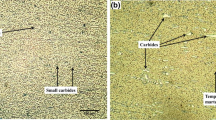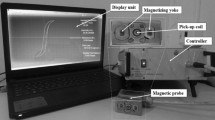Abstract
Nowadays, precision manufacturing industries are required faster surface inspection tools for the achievement of high productivity. In this context, the Barkhausen noise (BN) technique is adopted as a quick response technique in the grinding for qualitative evaluation of surface integrity of AISI D2 tool steel. Present work investigates the effect of eco-friendly coolant, i.e., cryogenic, on surface integrity of ground sample in the plunge grinding mode at different downfeed and compared with dry and wet environments. Surface integrity was assessed in respect of surface roughness, microstructure, and microhardness. Magnetic response of ground surface was reported by Barkhausen noise analyzer in the form of root mean square (rms), peak, and number of pulses. From the outcomes, it was perceived that no significant variations were found in the microstructure and microhardness of the ground surface and subsurface after cryo-grinding owing to lower thermo-mechanical loading. Besides, lower surface roughness was obtained in the case of cryo-grinding because of thermal softening effect. A linear correlation between BN input parameters, i.e., magnetic field intensity and BN responses at different magnetizing frequency could be achieved. Finally, better BN responses, including higher rms, peak, and number of pulses, were found under the cryogenic environment.









Similar content being viewed by others
REFERENCES
Malkin, S., Grinding technology: theory and applications of machining with Abrasives, Chichester: Ellis Horwoo, 1989.
Yin, G., Gong, Y., Li, Y., and Cheng, J., Research on force and temperature characteristics of novel point grinding wheels, Int. J. Mech. Sci., 2018, vol. 32, pp. 3817–3834.
Hong, S.Y., Economical and ecological cryogenic machining, J. Manuf. Sci. Eng., 2001, vol. 123, pp. 331–338.
Lasaosa, A., Gurruchaga, K., Arizti, F., and Martinez-De-Guerenu, A., Induction hardened layer characterization and grinding burn detection by magnetic Barkhausen noise analysis, J. Nondestr. Eval., 2017, vol. 36, p. 27.
Ivanova, Y., and Partalin, T., Comparative measurements of the stress state in a rolled carbon steel using magnetic Barkhäusen noise and ultrasonic method, Russ. J. Nondestr. Test., 2012, vol. 48, pp. 137–146.
Filinov, V.V., Arakelov, P.G., Kunin, N.T., and Golovchenko, D.A., To the question about the thickness of informative layer in magnetic-noise testing, Russ. J. Nondestr. Test., 2019, vol. 55, pp. 31–38.
Vashista, M., Gaddam, A., and Paul, S., Study of surface integrity of ground bearing steel using Barkhäusen noise technique, Int. J. Adv. Manuf. Technol., 2012, vol. 63, pp. 771–783.
Čilliková, M., Mičieta, B., Neslušan, M., and Blažek, D., Nondestructive magnetic monitoring of grinding damage, Procedia Mater. Sci., 2016, vol. 12, pp. 54–59.
Srivastava, A., Awale, A., Vashista, M., and Yusufzai, M.Z.K., Monitoring of thermal damages upon grinding of hard-ened steel using Barkhausen noise analysis, Int. J. Mech. Sci., 2020, vol. 34, pp. 2145–2151.
Dutra Xavier, S.E., Delijaicov, S., de Farias, A., Filho, M.S., and Batalha, G.F., Investigation on the surface integrity and tool wear in cryogenic machining, AIP Conf. Proc., 2011, vol. 1315, pp. 1199–1204.
Klocke, F., Settineri, L., Lung, D., Priarone, P.C., and Arft, M., High performance cutting of gamma titanium aluminides: Influence of lubricoolant strategy on tool wear and surface integrity, Wear, 2013, vol. 302, pp. 1136–1144.
Awale, A., Srivastava, A., Vashista, M., and Yusufzai, M.K., Influence of minimum quantity lubrication on surface integrity of ground hardened H13 hot die steel, Int. J. Adv. Manuf. Technol., 2019, vol. 100, pp. 983–997.
Meyers, M.A. and Chawla, K.K., Mechanical behavior of materials, Cambridge: Cambridge Univ. Press, 2008.
Kaynak, Y., Lu, T., and Jawahir, I., Cryogenic machining-induced surface integrity: a review and comparison with dry, MQL, and flood-cooled machining, Mach. Sci. Technol., 2014, vol. 18, pp. 149–198.
Chaudhari, A., Awale, A.S., and Chakrabarti, A.K., Surface integrity characterization of austenitic, martensitic and ferritic stainless steel under different grinding process, Mater. Res. Express, 2019, vol. 6, pp. 1165–1169.
Yuvaraj, N., and Kumar, M.P., Surface integrity studies on abrasive water jet cutting of AISI D2 steel, Mater. Manuf. Processes., 2017, vol. 32, pp. 162–170.
Singh, S., Awale, A., Chaudhari, A., and Nahak, B., Monitoring the microstructural changes of heat treated medium carbon steel by Barkhausen noise and hysteresis loop techniques, Mater. Today: Proc., 2020, vol. 26, pp. 1198–1202.
Noskova, N., Shulika, V., Lavrent’ev, A., Potapov, A., and Korzunin, G., Structure and Barkhausen effect parameters of amorphous alloys after various heat treatments, Russ. J. Nondestr. Test., 2004, vol. 40, pp. 620–624.
Gupta, S.K., Raja, A.R., Vashista, M., and Yusufzai, M.Z.K., Hysteresis loop analysis of gas metal arc welded ferritic stainless steel plate, Mater. Res. Express, 2019, vol. 6, article ID: 096110.
Vashista, M. and Paul, S., Novel processing of Barkhausen noise signal for assessment of residual stress in surface ground components exhibiting poor magnetic response, J. Magn. Magn. Mater., 2011, vol. 323, pp. 2579–2584.
Srivastava, A., Awale, A., Vashista, M., and Yusufzai, M.K., Characterization of Ground Steel Using Nondestructive Magnetic Barkhausen Noise Technique, J. Mater. Eng. Perform., 2020, vol. 29, pp. 4617–4625.
Gorkunov, E., Zadvorkin, S., and Goruleva, L., Comparison of Magnetic Parameters of Quenched Pipe Steels with X-Ray-Evaluated Residual Macro-and Microstresses, Russ. J. Nondestr. Test., 2019, vol. 55, pp. 369–377.
Jiles, D.C., Dynamics of domain magnetization and the Barkhausen effect, Czech. J. Phys., 2000, vol. 50, pp. 893–924.
Santa-Aho, S., Vippola, M., Sorsa, A., Latokartano, J., Lindgren, M., Leiviskä, K., and Lepistö, T., Development of Barkhäusen noise calibration blocks for reliable grinding burn detection, J. Mater. Process. Technol., 2012, vol. 212, pp. 408–416.
Deng, Y., Li, Z., Chen, J., and Qi, X., The effects of the structure characteristics on Magnetic Barkhausen noise in commercial steels, J. Magn. Magn. Mater., 2018, vol. 451, pp. 276–282.
Funding
Special thankfulness to IIT BHU for financial support under grant (letter No. IIT (BHU)/Dec/2013-14/5110/L) and Institute Research Project ((IIT (BHU)/R & D)/IRP/2015-16/2832).
Author information
Authors and Affiliations
Corresponding author
Rights and permissions
About this article
Cite this article
Sharma, A., Chaudhari, A., Awale, A.S. et al. Effect of Grinding Environments on Magnetic Response of AISI D2 Tool Steel. Russ J Nondestruct Test 57, 212–221 (2021). https://doi.org/10.1134/S1061830921030062
Received:
Revised:
Accepted:
Published:
Issue Date:
DOI: https://doi.org/10.1134/S1061830921030062




